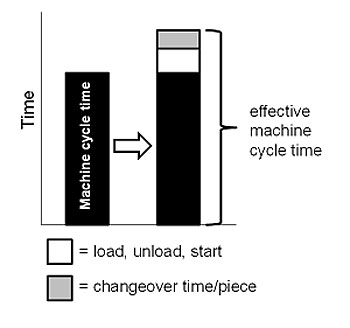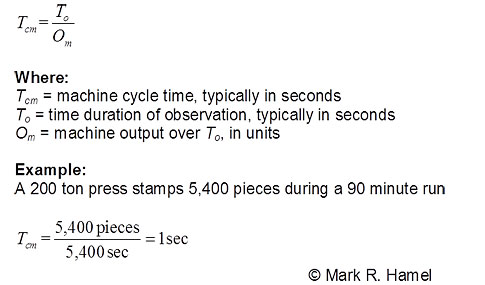Machine cycle time (Tcm) represents the actual time it takes for one machine to complete all of its operations on one piece, product, patient, file, etc. It is applicable for both single-piece and batch processing. Unlike effective machine cycle time, Tcm excludes load and unload time as well as any changeover time.
|
ADVERTISEMENT |
Although Tcm does not reflect operator time, it is critical to understand the relationship between the operator and machine within time and space. Tools such as standard-work combination sheets facilitate that understanding and may help identify opportunities for jidoka, which can be defined as automation with a human touch, and also provide an important comparison of operator cycle time and takt time.

As with any cycle-time measure, machine cycle time should be confirmed through direct observation of multiple cycles. Lean practitioners need to identify and understand significant machine cycle-time variation and address it appropriately.

…
Comments
Cycle time for duplicated machines
Hi,
I have been faced with a challenge at work. I have a testing machine which has an operator to load and unload. After the load the machine operates automatically. Because the machine test time is high and we are unable to meet the Target Cycle time, we have made a machine with multiple cavities. In which case my operator will just load into multiple cavities but each cavity will operate immediately after loading, irrelevant of waht is happening in the othe cavities.This how the cycle time calculation is done.
Usign 1 cavity
Loading - 3sec
Testing - 200sec
Unloading - 3sec
Giving CT per piece if 206sec
Using 12 cavity machine
Loading 3 sec
Testing : 200/12 = 16.7sec
Unloading : 3sec
Giving cycle time per piece of 22.7sec
But my team feel that the Loading and unloading time should also be divided by 12:
Using 12 cavity machine
Loading 3/12 = 0.25sec
Testing : 200/12 = 16.7sec
Unloading : 3/12 = 0.25sec
Giving cycle time per piece of 17.2sec
Below is a pictorial explanation of the situation.
Could you kindly advice please.
Add new comment